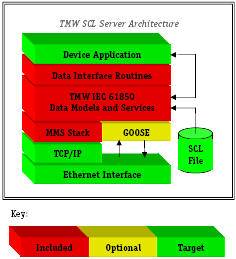What is IEC 61850?
IEC 61850 is an international standard originally designed for the integration of electric utility substation devices. It is also being extended for use in wind power generation and for the management of Distributed Energy Resources (DER). It includes several Ethernet-based communications protocols, along with standardized naming and object modeling. It also includes an XML-based Substation Configuration Language (SCL), which was developed to allow for the exchange of configuration data between tools. SCL is used to design, document and exchange both device level and substation level configurations. It is a much more comprehensive approach to integration standards than previous efforts in substation integration. IEC 61850 uses advanced communications techniques to address data management and simplify integration of applications.
What are Triangle MicroWorks, Inc. Software Libraries?
Triangle MicroWorks’ Software Libraries provide a cost-effective means of supporting industry-standard protocols in your device. Incorporating our royalty-free Software Libraries in your products will shorten development time, freeing internal resources to work on company proprietary aspects of your products. Several library configurations are available. The basic Server Library meets the needs of most device-level implementations. The GOOSE (Generic Object Oriented Substation Event) optional component implements an additional IEC 61850 protocol used for protection functions and other applications requiring high speed multicast peer-to-peer communications capabilities. The Client optional component can be used in a variety of embedded and non-embedded environments to provide very efficient high-speed client services. Most device level implementations use GOOSE services for peer-to-peer communications, and therefore do not require the Client optional component.
Features Common to All of Our IEC 61850 ANSI-Standard C Source Code Libraries
- Written in ANSI-Standard C Source Code.
- Designed to be processor and operating system independent, using any ANSI-Standard C compiler.
- Simple configuration for big-endian or little-endian byte order.
- Can be used with or without a Real Time Operating System (RTOS).
- Highly efficient code and advanced protocol parsing techniques designed to work well in embedded and workstation environments.
- Typical product integration times depend highly on the database model complexity.
IEC 61850 Server Source Code Library Features
- Support for total runtime configuration via local SCL file or API.
- Runtime or more efficient compile time configuration of logical nodes supported.
- Additional lower level interfaces available for specialized device integration requirements.
- Advanced data modeling techniques simplify generation of conformant servers.
- Implements IEC 61850 services within the library – not in user code.
- Integrates with application at object level – not transaction level.
- Efficient memory management; malloc() and free() only used at system startup.
IEC 61850 Client Option Features
- Application interface designed for ease of use, even in embedded environments.
- Supports all services required for IEC 61850.
- Highly efficient operation.
GOOSE Option Features
- Application interface designed to free application developers from protocol details.
- Integrated with data model features, including control blocks.
- Includes GSSE (Generic Substation Status Event) support.
- Implements IEC 61850 GOOSE protocol very efficiently.
This figure shows the major components of an IEC 61850 server implementation. The device application (process logic) is largely independent of the transaction sequences, etc. – integration is done mostly through the data interface routines. There is, however, an interface capability that allows the application code to get access to service and indications when needed. The Data Interface Routines allow the 61850 Data Object Models to be interfaced with the application process data of the device. The IEC 61850 services are implemented directly within the library, and generally do not require custom code.
The MMS (Manufacturing Message Specification, or ISO 9506) stack implements the actual IEC 61850 transactions over TCP/IP connections. The optional GOOSE package implements a simple but reliable multicast data exchange protocol directly over the Ethernet.
The architecture assumes that TCP/IP and Ethernet interfaces are available on the target platform. |  |
Quelle:
Triangle Microworks Inc.